Squirrel Appreciation Day is held on the 21st of January. Some may also refer to it as the ‘nuttiest day of the year’. Given that wildlife is a popular area of photography amongst beginners, we’ve got a guide full of ideas about photographing Squirrels.
This unusual celebration first began in 2001 in North Carolina by wildlife rehabilitator Christy McKeown, as a way of ensuring seeds and nuts were put out for the little fuzzy rodents.
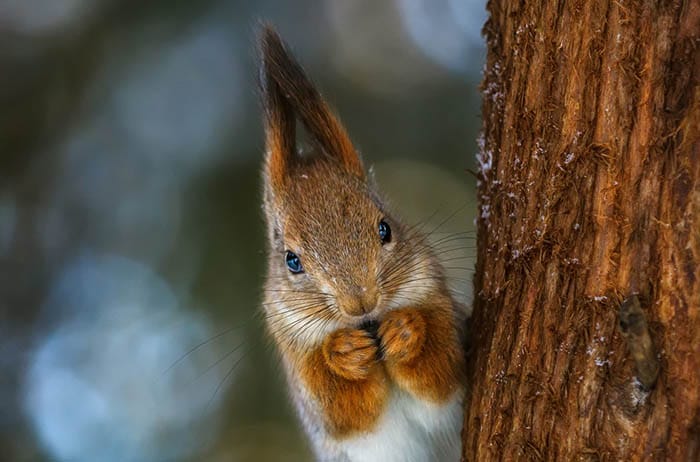
There are many different kinds of Squirrels found almost everywhere all over the world. Squirrels are native to:
• The Americas
• Africa
• Europe
• Asia
• Australia
Are you ready to come on a winter woodland adventure? If so, pack up your nuts, pick up your cameras, brace the cold and let’s get started searching for our mischievous friends. Don’t worry, we’ve put together some photography ideas and suggestions to help you along the way.
Depending on where you live, you have 2 different options. Firstly, if you have a garden featuring lots of trees and natural wildlife, you may already regularly strike it lucky with appearances from these quirky little fuzz-balls.
Otherwise, consider leaving food out in your garden or yard to entice them.
• Try scattering some corn at the base of your trees on the ground.
• Hang corn cobs from your washing line or from tree branches.
• Tie monkeys nuts (peanuts in shells) on strings; sit back and watch the squirrel acrobatic show.
• Entice them by sticking food into small gaps or holes in tree stumps or in the tree bark.
• Squirrels love nuts – so fill up your bird feeder and birdhouses with them!
You could try walnuts, pecans, almonds, macadamia – leftover nut nibbles from Christmas (only natural nuts though, no salt). Please make sure you do you research on squirrel feeding before disturbing their habitat or leaving dangerous left over foods out.
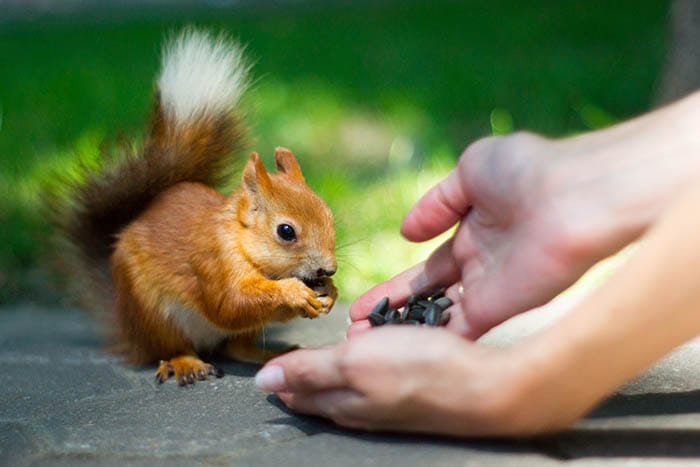
If you have tame squirrels in your garden, create fun scenes and make your shots creatively interesting.
Squirrels are very intelligent and will figure out ways to get their food, so hide it in interesting places or fun and unusual hollowed out objects.
To capture shots like these below, hang cocktail umbrellas (or other props) from pieces of cotton or wire, then attach nuts to the insides.
You can do the same sort of thing with balloons, tiny baskets of nuts, bird ladders, toy cars… the options are endless.
If using wire, string or cotton to set up assault courses and story scenes, don’t ever leave these set-ups unattended; you don’t want the squirrels (or other animals) getting tangled or trapped.
If you live in a city or built up area, you may need to venture out in search of woodlands. Consider local parks, national trust woods, small forests. You could even Google where is best to find squirrels in your local area for some suggestions.
Follow the same guides as above for garden squirrels; take nuts and corn along with you. You will need patience and squirrel detective senses as they are a master of disguise.
Please remember, whenever wildlife is concerned, there is no guarantee you will successfully find or spot them on your first trip out.
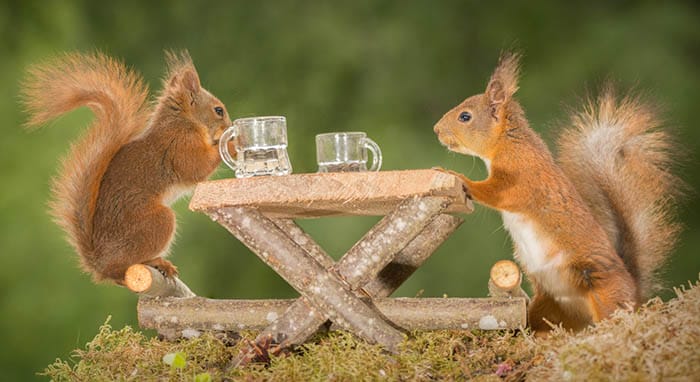
1. Get your children involved with searching and collecting hazelnuts, chestnuts and pinenuts (from pine cones).
2. Hide food inside large hollow items (like hollowed fruit or empty shells). Squirrels love to explore and find food.
3. Make a fun obstacle course and put a trail of nuts across it to encourage the squirrels to climb.
4. Decorate a birdhouse – squirrel themed and styled of course
5. Build a small wooden swing hammock or bridge for the squirrels to climb.
6. If you have relatively tame squirrels, dot miniature furniture around (think dolls house furniture) on the ground, in trees and hung from branches.

The winter months can be challenging with any type of photography, as there is often a great shortage of light and colour, and generally everything can appear a little grey and miserable.
Photographing in woodlands is a challenge, but also has its upsides; photographing squirrels in a ‘pool’ of natural light against a dark background can make for some striking and interesting shots.
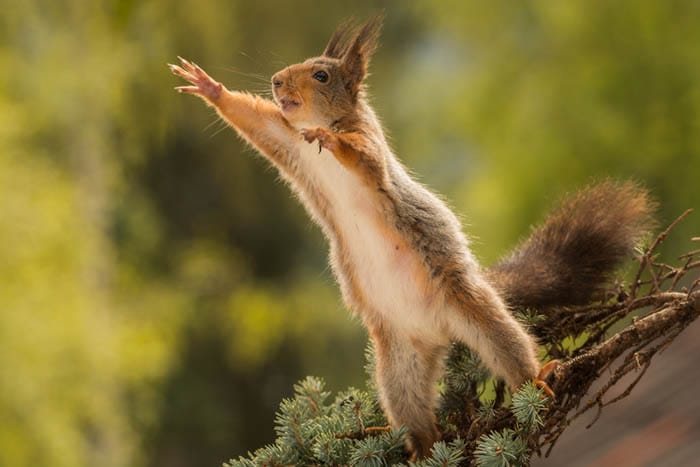
Now you’ve identified your location you need to prepare your kit. Remember there might not be time to change lenses and you’ll also want to be fairly static and quiet once in position.
A long zoom telephoto lens is probably the best bet, along with a nice all-rounder that will get you the shots you desire.
*Don’t forget if your image is not quite right you have the power of post processing, to crop or edit your image as you please afterwards.
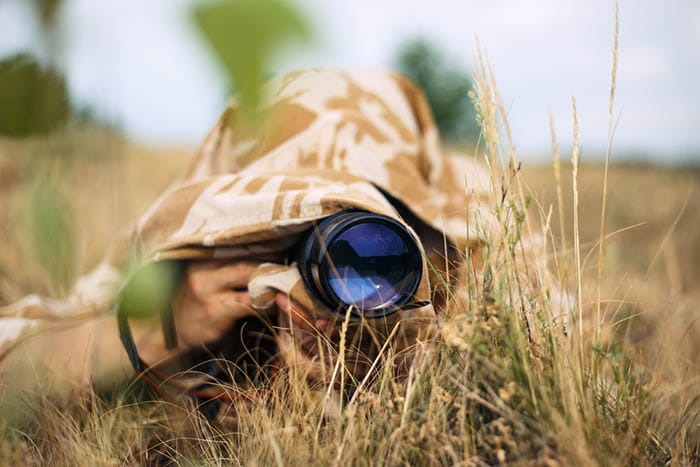
Now you’ve decided on lenses and kit, here are 10 tips on how to get the most out of your squirrel photography shoot:
• Set your white balance to AUTO or to a warmer temperature: this then helps to remove unrealistic colour casts, so that the squirrels look healthy and natural.
• It is advisable to use a mono or tripod to help prevent camera shake. If you don’t have one, rest your elbows on a firm steady surface, or place your camera on a static, flat surface or object (such as a rock, or mat on the ground).
• Crouch or lie down as low to the ground as possible. Make sure you are comfortable as you might be there for a while (depending on how patient you are and how accommodating the squirrels are feeling).
• Stay as still and quiet as possible; any movement on your part will cause the squirrels to run away, and then you can say bye-bye to that photograph.
• If possible, resist using the flash as this will scare the squirrel. Flash also holds the risk of presenting you with a red-eyed demon in your shot, instead of an adorable woodland animal.
• Take along some hazelnuts, unsalted peanuts or corn. These are irrisistable offerings to a squirrel and will help to get you up close and personal.

• Consider your shutter speeds and motion shots beforehand – these are fast little creatures, so freeze the action.
• You could also consider panning your shots or focusing on the point ahead of where the squirrel is initially positioned.
• Wait until the squirrel settles momentarily and then snap snap snap away! Don’t feel disheartened if you actually miss more shots than you get – after all, observing the squirrels is half of the fun.
• Above all else, be patient. Remember, all good things come to those who wait.
Finally, once you have collected your images, share your squirrel photography by changing your desktop image for all to view. If you’re an iPhotography member, show off your favourite Squirrel photos in the feedback gallery.
Otherwise tag us on Facebook, Twitter and Instagram. We can’t wait to view your woodland adventures!
Discover the BEST way on how to clean a camera sensor using swaps, rocket blowers and pencil brushes to give your shots a dust-free finish!
Capture the magic of the night with our beginner’s guide to night photography. Learn tips and techniques for stunning results.
Master the art of solar eclipse photography with expert tips on equipment, settings, and precautions for stunning celestial images.
Learn the basics of photography – fast – with our FREE 60-Second Photographer online course. Each class is short and sharp with simple, actionable steps that give you immediate results.
x 30 lessons

© iPhotography™
Become a confident and competent photographer in less than 30 minutes!
Before you leave, make sure you’ve secured your FREE online photography course (worth £29.99)
Each class is just 60-seconds or less making it the fastest and easiest way to learn photography!